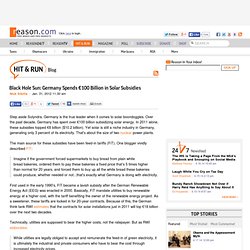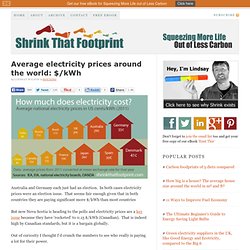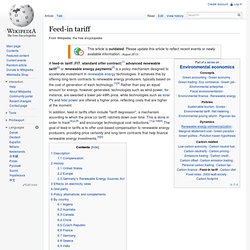

Ec.europa.eu/competition/sectors/energy/eeag_en. Black Hole Sun: Germany Spends €100 Billion in Solar Subsidies. Step aside Solyndra.

Germany is the true leader when it comes to solar boondoggles. Over the past decade, Germany has spent over €100 billion subsidizing solar energy. In 2011 alone, these subsidies topped €8 billion ($10.2 billion). Yet solar is still a niche industry in Germany, generating only 3 percent of its electricity. That's about the size of two nuclear power plants. The main source for these subsidies have been feed-in tariffs (FiT). Imagine if the government forced supermarkets to buy bread from plain white bread bakeries, ordered them to pay these bakeries a fixed price that’s 5 times higher than normal for 20 years, and forced them to buy up all the white bread these bakeries could produce, whether needed or not...that's exactly what Germany is doing with electricity.
First used in the early 1990's, FiT became a lavish subsidy after the German Renewable Energy Act (EEG) was enacted in 2000. Technically, utilities are supposed to bear the higher costs, not the ratepayer. Germany's Renewable Energy Subsidies Could Threaten Economic Growth. Germany's Renewable Energy Subsidies Could Threaten Economic Growth. Siteresources.worldbank.org/EXTESC/Resources/Subsidy_background_paper. Ec.europa.eu/energy/publications/doc/2013_pocketbook.
Www.misi-net.com/publications/NEI-1011.pdf. Www.misi-net.com/publications/NEI-1011.pdf. The World Bank. Commission unveils overhaul of renewable energy subsidies. Ec.europa.eu/energy/gas_electricity/doc/20121217_energy_market_2011_lr_en. CO2 emissions (metric tons per capita) Electricity pricing. Electricity pricing (sometimes referred to as electricity tariff or the price of electricity) varies widely from country to country, and may vary significantly from locality to locality within a particular country.

There are many reasons that account for these differences in price. The price of power generation depends largely on the type and market price of the fuel used, government subsidies, government and industry regulation, and even local weather patterns. Basis of electricity rates[edit] Electricity prices vary between countries and can even vary within a single region or distribution network of the same country. In standard regulated monopoly markets, electricity rates typically vary for residential, commercial, and industrial customers. Average electricity prices around the world: $/kWh. Australia and Germany each just had an election.

In both cases electricity prices were an election issue. That seems fair enough given that in both countries they are paying significant more $/kWh than most countries But now Nova Scotia is heading to the polls and electricity prices are a key issue because they have ‘rocketed’ to 0.15 $/kWh (Canadian). That is indeed high by Canadian standards, but it is a bargain globally. Out of curiosity I thought I’d crunch the numbers to see who really is paying a lot for their power. Electricity prices around the world in $/kWh It doesn’t matter where you go in the world, people love to moan about the cost of electricity. This begs the question, where is electricity actually expensive and where is it cheap. To try and answer this question I’ve collected average electricity prices from 17 countries around the world, and converted them to $/kWh (US). Feed-in tariff.
A feed-in tariff (FIT, standard offer contract)[1] advanced renewable tariff[2] or renewable energy payments[3] is a policy mechanism designed to accelerate investment in renewable energy technologies.

It achieves this by offering long-term contracts to renewable energy producers, typically based on the cost of generation of each technology.[1][4] Rather than pay an equal amount for energy, however generated, technologies such as wind power, for instance, are awarded a lower per-kWh price, while technologies such as solar PV and tidal power are offered a higher price, reflecting costs that are higher at the moment. In addition, feed-in tariffs often include "tariff degression", a mechanism according to which the price (or tariff) ratchets down over time. Description[edit] FITs typically include three key provisions:[7][8] High Energy Costs Plaguing Europe. Solar Power Begins to Shine as Environmental Benefits Pay Off. According to the European Environment Agency, Europe had already achieved an emissions reduction of 18 percent by last year, putting it on course to overshoot the 2020 target, even if the E.U. economy recovers by then.

According to the E.P.I.A., the photovoltaic industry lobby group, 10 of the 27 E.U. member states had already achieved their 2020 photovoltaic targets by 2012, and most of the others were close. With many European consumers squeezed between stagnant or falling incomes and soaring power bills, and governments desperately trying to cut back on public sector spending liabilities, green feed-in tariffs have come under increasingly sharp attack in the past year. Last month, for example, the British government agreed to a 35-year guaranteed price for power from a new nuclear plant to be operated by the French utility EDF. Although cost of living concerns have increasingly been raised by critics seeking to roll back green energy incentives, Ms. Rupert Darwall: Europe's Stark Renewables Lesson. Ional Record Senate Articles. Www.finance.senate.gov/imo/media/doc/Zycher Senate Finance renewables incentives testimony 3-27-12.pdf. Www.inhofe.senate.gov/download/?id=e0a37b82-fc70-48ff-b1fb-3293ca76dd39&download=1.
Climate and energy country profiles – Key facts and figures for EEA member countries. Energy and environment report 2008. Trends and projections in Europe 2013 – Tracking progress towards Europe's climate and energy targets until 2020. Energy and environment report 2008. Energy_FINAL_web (1) European Union. The European Union (EU) is an economic and political union of 28 member states that are located primarily in Europe.[12][13] The EU operates through a system of supranational independent institutions and intergovernmental negotiated decisions by the member states.[14][15] Institutions of the EU include the European Commission, the Council of the European Union, the European Council, the Court of Justice of the European Union, the European Central Bank, the Court of Auditors, and the European Parliament.

The European Parliament is elected every five years by EU citizens. The EU traces its origins from the European Coal and Steel Community (ECSC) and the European Economic Community (EEC), formed by the Inner Six countries in 1951 and 1958, respectively. In the intervening years the community and its successors have grown in size by the accession of new member states and in power by the addition of policy areas to its remit. History Evolution through treaties Geography. Industry wins concessions on EU energy subsidies. Commission unveils overhaul of renewable energy subsidies.